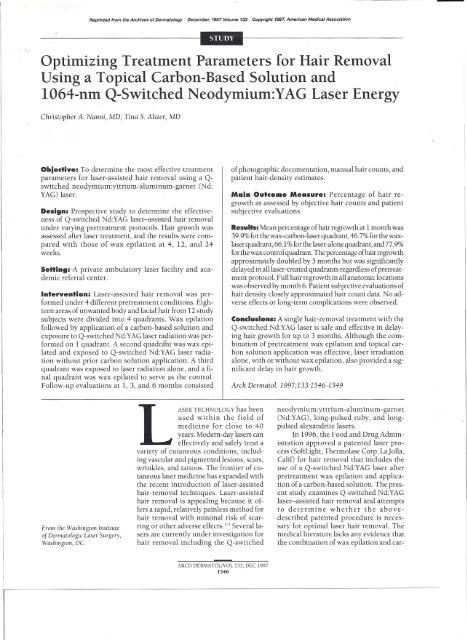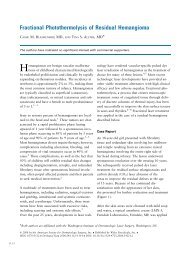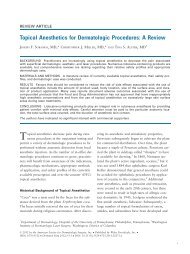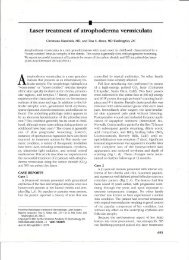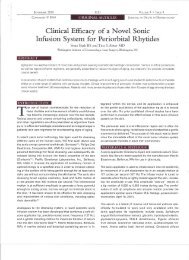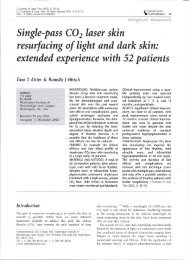Optimizing Treatment Parameters For Hair Removal Using A
Optimizing Treatment Parameters For Hair Removal Using A
Optimizing Treatment Parameters For Hair Removal Using A
Create successful ePaper yourself
Turn your PDF publications into a flip-book with our unique Google optimized e-Paper software.
Reprinted from the Archives of Dermatology December, 1997 lib/ume 133 Copyright 1997, American Medical Association<br />
--------------------------------------~IIIIIIaIIII~--------------------------------------<br />
<strong>Optimizing</strong> <strong>Treatment</strong> <strong>Parameters</strong> for <strong>Hair</strong> <strong>Removal</strong><br />
<strong>Using</strong> a Topical Carbon-Based Solution and<br />
l064-nm Q-Switched Neodymium:YAG_Laser Energy<br />
Christopher A. Nanni, MD; Tina S. Alster, MD<br />
Obiective: To determine the most effective treatment<br />
parameters for laser-assisted hair removal using a Q-<br />
switched neodymium:yttrium-aluminum-garnet (Nd:<br />
YAG) laser.<br />
Design: Prospective study to determine the effectiveness<br />
of Q-switched Nd:YAG laser-assisted hair removal<br />
under varying pretreatment protocols. <strong>Hair</strong> growth was<br />
assessed after laser treatment, and the results were compared<br />
with those of wax epilation at 4, 12, and 24<br />
weeks.<br />
Selling:'A private ambulatory laser facility and academic<br />
referral center.<br />
Intervention: Laser-assisted hair removal was performed<br />
under 4 different pretreatment conditions. Eighteen<br />
areas of unwanted body and facial hair from 12 study<br />
subjects were divided into 4 quadrants. Wax epilation<br />
followed by application of a carbon-based solution and<br />
exposure to Q-switched Nd:YAG laser radiation was performed<br />
on 1 quadrant. A second quadrant was wax epilated<br />
and exposed to Q-switched Nd:YAG laser radiation<br />
without prior carbon solution application. A third<br />
quadrant was exposed to laser radiation alone, and a final<br />
quadrant was wax epilated to serve as the control.<br />
Follow-up evaluations at 1,3, and 6 months consisted<br />
of photographic documentation, manual hair counts, and<br />
patient hair-density estimates.<br />
Main Outcome Measure: Percentage of hair regrowth<br />
as assessed by objective hair counts and patient<br />
subjective evaluations.<br />
Results: Mean percentage of hair regrowth at 1 month was<br />
39.9% for the wax-carbon-laser quadrant, 46.7% for the waxlaser<br />
quadrant, 66.1% for the laser-alone quadrant, and 77.9%<br />
for the wax control quadrant. The percentage ofhairregrowth<br />
approximately doubled by 3 months but was significantly<br />
delayed in all laser-treated quadrants regardless of pretreatment<br />
protocol. Full hair regrowth in all anatomic locations<br />
was observed by month 6. Patient subjective evaluations of<br />
hair density closely approximated hair count data. No adverse<br />
effects or long-term complications were observed.<br />
Conclusions: A single hair-removal treatment with the<br />
Q-switched Nd:YAG laser is safe and effective in delaying<br />
hair growth for up to 3 months. Although the combination<br />
of pretreatment wax epilation and topical carbon<br />
solution application was effective, laser irradiation<br />
alone, with or without wax epilation, also provided a significant<br />
delay in hair growth.<br />
Arch Dermato!' 1997;133:1546-1549<br />
From the Washington Institute<br />
of Dennatologie Laser SurgelY,<br />
Washington, DC.<br />
LASER TECHNOLOGY has been<br />
used within the field of<br />
medicine for close to 40<br />
years. Modern-day lasers can<br />
effectively and safely treat a<br />
variety of cutaneous conditions, including<br />
vascular and pigmented lesions, scars,<br />
wrinkles, and tattoos. The frontier of cutaneous<br />
laser medicine has expanded with<br />
the recent introduction of laser-assisted<br />
hair-removal techniques. Laser-assisted<br />
hair removal is appealing because it offers<br />
a rapid, relatively painless method for<br />
hair removal with minimal risk of scarring<br />
or other adverse effects. 1-5 Several lasers<br />
are currently under investigation for<br />
hair removal including the Q-switched<br />
neodymium:yttrium-aluminum-garnet<br />
CNd:YAG), long-pulsed ruby, and longpulsed<br />
alexandrite lasers.<br />
In 1996, the Food and-Drug Administration<br />
approved a patented laser process<br />
(Softl.ight, Thermolase Corp, Lajolla,<br />
Calif) for hair removal that irlcludes the<br />
use of a Q-switched Nd:YAG laser after<br />
pretreatment wax epilation and application<br />
of a carbon-based solution. The present<br />
study examines Q-switched Nd:YAG<br />
laser-assisted hair removal and attempts<br />
to determine whether the abovedescribed<br />
patented procedure is necessary<br />
for optimal laser hair removal. The<br />
medical literature lacks any evidence that<br />
the combination of wax epilation and car-<br />
ARCH DERMATOUVOL 133, DEC 1997<br />
1546
SUBJECTS<br />
AND METHODS<br />
100<br />
11IIWax + Carbon + Laser<br />
11IIWax + Laser<br />
Twelve subjects (3 men and 9 women; mean age, 32<br />
years) were enrolled in the study. A total of 18 anatomic<br />
locations were evaluated, including 6 backs,<br />
3 upper lips, 1 chin, and 8 legs. Potential subjects with<br />
evidence of endocrine dysfunction, immune suppression,<br />
recent oral retinoid use, drug-induced<br />
hypertrichosis, sensitivity to infrared light, photosensitivity,<br />
collagen vascular disease, or androgenproducing<br />
tumor were excluded. Skin type, sex, hairremoval<br />
history, and patient age were recorded. All<br />
skin types were considered for inclusion, although<br />
only skin types I through IV were represented. Only<br />
subjects with black or brown terminal hair were<br />
included.<br />
A Q-switched Nd:YAG laser (Thermolase Corp)<br />
was used at a fluence of 2.6 j/crrr', a wavelength of<br />
1064 nm, a pulse duration of 50 nanoseconds, a 7-mm<br />
spot size, and a pulse repetition rate of 10 Hz. Study<br />
areas on the back and legs were divided into 3-cm 2<br />
quadrants using a standard template. Facial areas were<br />
divided into I-crrr' quadrants using a smaller template.<br />
<strong>Treatment</strong> sites were placed in a linear fashion,<br />
with orientation and location randomized for each<br />
anatomic area. Pretreatment protocol in 1 quadrant<br />
consisted of wax epilation and carbon-based solution<br />
application (Thermolase Corp) with subsequent<br />
"laser irradiation using the above set parameters.<br />
A second quadrant was wax epilated (without<br />
carbon solution) and exposed to laser radiation. A<br />
third area was exposed to laser radiation without any<br />
pretreatment waxing or carbon solution application.<br />
The last quadrant was simply wax epilated and<br />
served as a control. Those sites pretreated with carbon<br />
solution retained a thin film of surface carbon<br />
after gentle wiping of excess solution with dry gauze.<br />
The pretreated skin was subsequently irradiated<br />
within 15 minutes after the application of carbon<br />
solution.<br />
Evaluations at 1, 3, and 6 months after treatment<br />
consisted of consecutive photographic documentation<br />
using identical lighting, camera, and patient<br />
positioning (Mirror Image System, Virtual<br />
Eyes Inc, Kirkland, Wash); manual hair counts; and<br />
subjective patient hair-density estimates. <strong>Hair</strong>-density<br />
estimates were based on each patient's subjective<br />
evaluation using a scale of no hair growth,<br />
minimal or moderate growth, and thick hair growth<br />
as options.<br />
The number of terminal hairs present after treatment<br />
were compared with baseline hair counts. The<br />
percentage of hair regrowth was defined as the percentage<br />
of hairs that were present after treatment compared<br />
with baseline hair counts. Anatomic locations<br />
were grouped and analyzed separately. The percentage<br />
of hair regrowth was calculated for each study<br />
quadrant. Paired-difference t tests were used to compare<br />
treatments. Wilcoxon signed-rank tests of the<br />
paired differences were also performed for confirmation.<br />
Hochberg improved Bonferroni procedure<br />
was used to maintain a joint significance level of .05<br />
for the 4 tests within a single time point.<br />
80<br />
.x:<br />
! 60<br />
~a:<br />
~ 40<br />
20<br />
Figure 1. Mean percentage of patient hair regrowth.<br />
Waxing<br />
+<br />
Solution<br />
+<br />
Laser<br />
Waxing<br />
+<br />
Laser<br />
Waxing<br />
Alone<br />
Laser<br />
Alone<br />
Figure 2. A 45-year-old man with pigmented terminal hairs on the back<br />
before treatment.<br />
bon solution application followed by Q-switched Nd:<br />
YAG laser irradiation is more effective than wax epilation<br />
alone. It is also unclear whether the timeconsuming<br />
and messy procedure of waxing and carbon<br />
solution application is more efficacious than laser irradiation<br />
alone when used on hair-bearing skin. Therefore,<br />
the present study served to evaluate hair growth<br />
within 3 laser-treated sites with differing pretreatment<br />
protocols using a fourth wax-epilated site as a control.<br />
RESULTS<br />
<strong>Hair</strong> regrowth was evaluated by hair counts and subjective<br />
patient evaluations of hair density at each of the 3<br />
follow-up visits (at 1, 3, and 6 months). The mean percentage<br />
of regrowth (Figure 1) at 1 month was 39.9%<br />
(P
Thick<br />
Growth<br />
11II Wax + Carbon + Laser<br />
iim Wax + Laser<br />
1<br />
o Laser Alone<br />
11IIControl<br />
--<br />
Moderate<br />
Growth<br />
-<br />
Waxing<br />
+<br />
Solution<br />
+<br />
Laser<br />
Waxing<br />
+<br />
Laser<br />
Waxing<br />
Alone<br />
Laser<br />
Only<br />
Figure 3. Same area as in Figure 2 one month after Q-switched<br />
neodymium:yytrium-aluminum-garnet (Nd:YAG) laser treatment with various<br />
pretreatment preparations using a wax-epilated region as a control.<br />
<strong>Treatment</strong> areas demonstrate 20% regrowth in Waxing + Solution + Laser<br />
site, 24% regrowth in Waxing + Laser site, 85% regrowth in Waxing Alone<br />
(control) site, and 61% regrowth in Laser Only site.<br />
Minimal<br />
Growth<br />
No<br />
Gro~ ~~ _ __ ~ ~~ _ __<br />
o 1 3 6<br />
Month<br />
Figure 6. Patient hair-density estimates.<br />
month follow-up evaluation. Several patients, however,<br />
reported that their hair quality had changed after laser<br />
treatment, the regrown hairs exhibiting finer texture and<br />
lighter color. This change in hair quality could not be<br />
easily judged by photographic analysis and therefore could<br />
not be supported by objective data. Other than a transient<br />
folliculitis that developed in 3 wax-epilated test quadrants,<br />
no cutaneous pigmentary or textural complications<br />
developed after laser treatment.<br />
COMMENT<br />
Waxing<br />
+<br />
Solution<br />
+<br />
Laser<br />
Waxing<br />
+<br />
Laser<br />
Waxing<br />
Alone<br />
Laser<br />
Only<br />
Figure 4. Region seen in Figures 2 and 3 three months after 1 treatment.<br />
<strong>Treatment</strong> areas demonstrate 35% regrowth in Waxing + Solution +<br />
Lasersite, 40% regrowth in Waxing + Laser site, 94% regrowth in Waxing<br />
Alone (control) site, and 77% regrowth in Laser Only site.<br />
Waxing<br />
+<br />
Solution<br />
+<br />
Laser<br />
Waxing<br />
+<br />
Laser<br />
Waxing<br />
Alone<br />
Laser<br />
Alone<br />
Figure 5. Six-month follow-up photograph shows full hair regrowth in all<br />
treatment areas.<br />
mal distribution. All hypothesis tests and associated P values<br />
are 2 sided.<br />
Patient subjective hair-density estimates reflected the<br />
objective hair count data (Figure 6). Full hair regrowth<br />
occurred in all study quadrants based on hair<br />
counts and patient hair-density estimates by the 6-<br />
<strong>Hair</strong> removal has become a major research interest and<br />
economic force within the field of cutaneous laser medicine.<br />
Laser systems with differing wavelengths, pulse durations,<br />
and energy densities are currently under development<br />
for hair removal, based largely on unproven<br />
theories and vague mechanisms of action. While the<br />
theory of selective photo thermolysis could be used to optimize<br />
wavelengths and pulse durations for laser epilation,<br />
the exact target within the hair follicle has yet to<br />
be clearly established." The hair matrix, papilla, and bulge<br />
are all potential areas of hair follicle vulnerability. However,<br />
without knowledge of a specific follicular target, it<br />
becomes difficult to predict which laser wavelengths and<br />
pulse durations will be most successful.<br />
At the time of study initiation, only 1 laser-assisted<br />
hair-removal device had been approved for use by the<br />
Food and Drug Administration (the SoftLight system by<br />
Thermolase Corp). This system uses energy from a Q-<br />
switched Nd:YAG laser following pretreatment wax epilation<br />
and application of a patented carbon-based topical<br />
solution. It provides an exogenous target chromophore<br />
(eg, carbon) to which l064-nm-wavelength laser light<br />
has an affinity. The carbon is theoretically placed within<br />
wax-epilated follicles, and laser-induced thermal and photoacoustic<br />
damage is subsequently produced within the<br />
follicular structure. Selective damage, then, remains independent<br />
of the presence of endogenous melanin.<br />
The results of this study suggest that after a single<br />
Q-switched Nd:YAG laser treatment, a change within the<br />
hair follicle is produced that results in a delay of hair regrowth.<br />
However, permanent hair removal (cessation of<br />
hair growth in treatment areas for the lifetime of the pa-<br />
ARCH DERMATOUVOL l33, DEC 1997<br />
1548
- ~I<br />
tient) was not achieved. All treatment sites exhibited full<br />
hair regrowth by 6 months, with some patients demonstrating<br />
regrowth as early as 1 and 3 months. While the<br />
ideal goal of laser-assisted epilation is permanence, the<br />
results of this study are consistent with those of previous<br />
studies involving single-session laser hair removal.<br />
Goldberg' reported that Q-switched Nd:YAG laser treatment<br />
and application of carbon solution provided a reduction<br />
in hair growth for up to 6 months. Grossman et<br />
aP reported a delay in hair growth for a 6-month period<br />
after long-pulsed normal-mode ruby laser irradiation. This<br />
apparent lack of permanence after laser hair removal has<br />
been disappointing, but not entirely unexpected, considering<br />
the vulnerability of hair to treatment at different<br />
phases in its growth cycle. Electrolysis, for example,<br />
requires numerous treatment sessions to effect a permanent<br />
reduction in hair growth. 7In a similar manner, it is<br />
quite possible that permanent epilation will emerge a reality<br />
only after multiple laser treatments.P Repeated laser<br />
injury to the hair follicle, which was not examined<br />
in the current study, should be investigated. Future studies<br />
should also address the question ofwhether laser light<br />
simply induces a prolonged telogen hair cycle or whether<br />
irreversible follicular damage is possible. Ultimately, histologic<br />
examination of treated hirsute sites will be necessary<br />
to fully understand the mechanisms of laserassisted<br />
hair re~oval.<br />
Although pretreatment with wax epilation and a topical<br />
carbon solution resulted in significant hair removal,<br />
this protocol was not essential. All laser-treated sites<br />
showed less hair regrowth at 3 months than the waxepilated<br />
control quadrants, suggesting that the laser energy<br />
can target the follicle without an exogenous carbon<br />
chromophore. However, because of the limited<br />
number of anatomic regions treated in this study, we<br />
lacked the statistical power to determine if a particular<br />
pretreatment protocol was superior to another.<br />
It is interesting to note that the quadrants that were<br />
simply exposed to laser radiation without waxing or carbon<br />
solution did not show a significant reduction in hair<br />
growth until the third month. This finding may be attributed<br />
to the fact that, in areas that were not wax epilated,<br />
laser irradiation caused the terminal hairs to whiten<br />
but to remain in the follicles. Although the hair shafts<br />
were injured, hair counts at 1 month included these depigmented<br />
hair shafts. By the third month, however, the<br />
injured hairs had fallen out of the follicles and a significant<br />
reduction in hair counts was recorded.<br />
While the results of this study suggest that wax epilation<br />
and/or carbon-based solution application is not essential<br />
to the laser-assisted hair-removal process, it is important<br />
to note that all study subjects had brown or black<br />
hair. When blonde or white hair-bearing areas are being<br />
treated, exogenous carbon pigment application may play<br />
a more important role in selectively targeting and concentrating<br />
laser energy into the follicle. Presumably,<br />
melanocytes and melanin within the hair follicle and shaft<br />
are the primary targets of Q-switched Nd:YAG laser energy<br />
when the laser treatment is used without a carbon<br />
solution. These melanin-producing cells are located within<br />
the hair matrix at the base of the follicle, the infundibulum,<br />
and sparsely within the outer root sheath.P" As there<br />
are greater numbers of melanocytes within the hair follicle<br />
than there are within the epidermis, laser energy can<br />
pass through the skin surface and be absorbed selectively<br />
by follicular melanin." This selective process obviously becomes<br />
more problematic when lighter hair colors are being<br />
treated. Gray hair, for instance, has fewer melanocytes<br />
at the hair bulb, and blonde hair has a decreased<br />
number of partially pigmented melanosomes as compared<br />
with black hair." Therefore, exogenous pigment in<br />
the form of a carbon-based solution may be helpful in the<br />
treatment of individuals with lighter hair colors.<br />
In conclusion, a single treatment with a Q-<br />
switched Nd:YAG laser results in a greater delay of hair<br />
growth (up to 6 months) when compared with wax epilation<br />
alone. Regardless of the use of pretreatment wax<br />
epilation or carbon topical solution, hair growth was decreased<br />
when compared with control (waxed) areas. Complete<br />
hair regrowth occurred by 6 months after a single<br />
treatment, suggesting that further research is needed to<br />
determine the optimal treatment intervals, energy settings,<br />
wavelengths, and pulse durations needed to achieve<br />
longer-lasting or permanent laser-assisted hair removal.<br />
Accepted for publication August 18, 1997.<br />
Reprints: Tina S. Alster, MD, Washington Institute of<br />
Dermatologic Laser Surgery, 2311 M St NW, Suite 200,<br />
Washington, DC 20037.<br />
REFERENCES<br />
1. Goldberg OJ.Topical solution-assisted laser hair removal Lasers Surg Med. 1995;<br />
suppl 7:47. Abstract.<br />
2. Goldberg OJ. Topical suspension assisted laser hair removal: treatment of axillary<br />
and inguinal regions. Lasers Surg Med. 1996;suppI8:195. Abstract.<br />
3. Grossman MG, Dierickx G, Farinelli W, et al. Damage to hair follicles by normalmode<br />
ruby pulses. JAm Acad Dermatol. 1996;35:889-894.<br />
4. Grossman MG, Wimberly J, Dwyer P, et at. PDTfor hirsutism. Lasers Surg Med.<br />
1995;suppl 7:47. Abstract.<br />
5. Alster TS. Manual of Cutaneous Laser Techniques. Philadelphia, Pa: Lippincott-<br />
Raven Publishers; 1996:128-134.<br />
6. Anderson RR, Parrish JA. Selective photothermolysis: precise microsurgery by<br />
selective absorption of pulsed radiation. Science. 1983;220:524-527.<br />
7. Richards RN, Meharg GE. Electrolysis: observations from 13 years and 140,000<br />
hours of experience. JAm Acad Dermatol. 1995;33:662-668.<br />
8. McKee PH. Pathology of the Skin. London, England: Mosby-Wolfe; 1996:1.20-<br />
1.21.<br />
9. Olsen EA. Disorders of <strong>Hair</strong> Growth. New York, NY: McGraw-Hili Book Go; 1994:<br />
52-55.<br />
/<br />
ARCH DERMATOUVOL 133, DEC 1997<br />
1549<br />
Printed and Published in the United States of America


